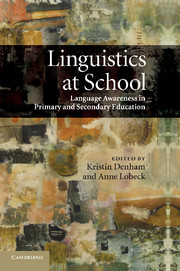Book contents
- Frontmatter
- Contents
- Notes on contributors
- Foreword: The challenge for education
- Introduction
- Part I Linguistics from the top down: encouraging institutional change
- Part II Linguistics from the bottom up: encouraging classroom change
- Introduction to Part II
- 9 From cold shoulder to funded welcome: lessons from the trenches of dialectally diverse classrooms
- 10 Positioning linguists as learners in K-12 schools
- 11 Fostering teacher change: effective professional development for sociolinguistic diversity
- 12 On promoting linguistics literacy: bringing language science to the English classroom
- 13 Linguistics in a primary school
- 14 Educating linguists: how partner teaching enriches linguistics
- 15 The Linguistic Olympiads: academic competitions in linguistics for secondary school students
- Part III Vignettes: voices from the classroom
- References
- Index
9 - From cold shoulder to funded welcome: lessons from the trenches of dialectally diverse classrooms
Published online by Cambridge University Press: 04 August 2010
- Frontmatter
- Contents
- Notes on contributors
- Foreword: The challenge for education
- Introduction
- Part I Linguistics from the top down: encouraging institutional change
- Part II Linguistics from the bottom up: encouraging classroom change
- Introduction to Part II
- 9 From cold shoulder to funded welcome: lessons from the trenches of dialectally diverse classrooms
- 10 Positioning linguists as learners in K-12 schools
- 11 Fostering teacher change: effective professional development for sociolinguistic diversity
- 12 On promoting linguistics literacy: bringing language science to the English classroom
- 13 Linguistics in a primary school
- 14 Educating linguists: how partner teaching enriches linguistics
- 15 The Linguistic Olympiads: academic competitions in linguistics for secondary school students
- Part III Vignettes: voices from the classroom
- References
- Index
Summary
Spring, 2000: During the fall of 2000, I initiated exploratory research in a “majority minority” school division, where a majority of the system's students were African American. My intent had been to ascertain (1) whether student vernacular language patterns transferred to student writing and (2) how teachers conceived of and responded to student vernacular. My hypothesis was that student vernacular language did occur in student writing and that teachers would take a traditional, correctionist approach to student vernacular. If so, my next step would be to initiate professional development for teachers in sociolinguistic approaches to language varieties and research-based approaches for teaching Standard English, in order to improve students' performance on year-end, state-wide tests of writing. The grant writer for the district had organized this meeting; I was one item on a much larger agenda.
With dozens of school principals in the audience, I was to share the results of my linguistic analysis of urban 3rd-grade writing. Analysis of approximately 100 essays from five, 3rd-grade classrooms had revealed nearly three dozen, African American English syntactic patterns (subject–verb agreement; be understood; past time shown by context; possessive shown by adjacency; plurality shown by context; a v. an, and so on) occurring in the writing of local Tidewater, Virginia students (see Figure 9.1 for an example of one of these essays). As expected, teachers saw student writing as error-filled, with missing endings, and they saw students as confused and stumbling with English. The room was packed.
- Type
- Chapter
- Information
- Linguistics at SchoolLanguage Awareness in Primary and Secondary Education, pp. 129 - 148Publisher: Cambridge University PressPrint publication year: 2010
- 1
- Cited by



